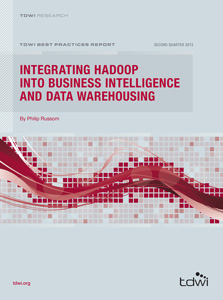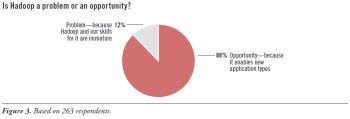 View online: tdwi.org/flashpoint
View online: tdwi.org/flashpoint





August 1, 2013
ANNOUNCEMENTS
NEW TDWI Checklist Report:
Where Hadoop Fits in Your Data Warehouse Architecture
CONTENTS

Creating a Fan Base for Your Data Governance Program

Best Practices for Adopting Agile Methodologies for Data Warehouse Development

Hadoop: Problem or Opportunity for BI/DW?

Mistake: Failing to Cultivate Agile Mindsets and Attitudes

See what's
current in TDWI Education, Events, Webinars,
and Marketplace

Creating a Fan Base for Your Data Governance Program
Tina McCoppin
Ajilitee
Topics:
Data Management
Your data governance program is up and running. The team is in place to manage it and … you realize that few people outside your team know what a data governance (DG) program is or why it exists. You already know that data governance programs work best when your team isn’t made up of those assigned to it, but instead is a corporate-wide effort to improve business outcomes and make data quality a priority.
Why won’t people spend more time better understanding the DG program, yet they’ll spend hours debating and searching for the right fantasy football picks or cruising Pinterest for great wall art?
Because of fast-paced work environments, your DG program competes against many factors (voicemail, e-mail, personal and professional responsibilities, and even Pinterest and football pools), and getting people on board can be difficult.
You can overcome these challenges with marketing. By looking at data governance as a product that needs to be marketed, you can generate awareness, understanding, and support for your DG program as well as influence behavioral change. Best of all, you don’t need a degree in marketing to borrow a few best practices to influence the success and adoption of your program. This three-step process is a great place to start.
Step 1: Plan Your Data Governance Marketing Strategy
The business case for your data effort wasn’t thrown together--the marketing of your DG program shouldn’t be either. Assess the situation on the ground first. I suggest a quick SWOT (strengths, weaknesses, opportunities, and threats) analysis of your data governance program to start: Where are we successful? Where do we continue to struggle? What are some new opportunities for DG?
After careful SWOT analysis (or the self-assessment method of your choice), you can better identify the opportunities your program has for making improvements with the greatest impact and benefits. You can then flesh out your DG marketing plan and tactics. As with any business case, present your plan, secure buy-in, and maintain and grow support for your achievements by demonstrating value. All of this requires careful marketing of your program and plan.
Step 2: Select Your Marketing Vehicles
You can borrow from some basic marketing tools to start evangelizing your program:
Collateral and communications: PowerPoint presentations can be turned into educational pieces about your DG program. You should consider having two versions: a 10-minute overview for use when you are a guest speaker and have limited time, and a 30- to 40-minute version for keynotes. You can also prepare brief updates for internal e-mail, newsletters, and other forms of internal communications. Contribute data governance content for your Intranet, newsletter, or portal articles. Often the people in charge of managing this content love to receive fresh, contributed material and will be open and eager to include your DG program information if it is timely and newsworthy and if you can demonstrate that it is of interest or importance to the audience.
Team and enterprise events: Participate in internal events whenever possible. Use the PowerPoint content you create and suggest including it in “lunch and learn” sessions, group meetings, and formal employee training sessions.
Organization constructs: Align your department with other departments and meetings and events that complement your data governance efforts. You might consider including the project management office and their “gate” (sign-off review of a project phase), IT audits, system development life cycle reviews, risk review meetings, or other committee meetings you find relevant.
Executive meetings: Whenever possible, contribute slides or offer a five-minute update about your DG program for inclusion on the agenda. At the executive level, you should keep your focus on organizational impact and business results.
PR, awards, and social media: There’s significant interest in shared knowledge and experience in DG endeavors. Your industry colleagues want to hear your best practices and insights. You can comb through some of your favorite magazines and conferences for ways to nominate your team and your project for awards and recognition or plan a social media message to your followers and contacts.
Step 3: Know What to Communicate--and Do It!
Know what to communicate with these great marketing tools. At a minimum, the data governance “message” should discuss:
- What is DG?
- Why do we need it here?
- What are the benefits of DG? (Try to tailor this to your audience.)
As you develop and grow your data governance program, additional DG material, information, and artifacts should become part of a stream of marketing messages to the business and IT community involved in governance. These might include DG policies, metrics and outcomes, the business case for the DG program, project status, anecdotes of successes and challenges, and external articles about DG from the media.
A Delicate Balance
You must delicately balance communicating frequently without oversaturating the audience. Keep your efforts fresh and interesting--don’t always limit your focus to “data” but stress the importance of well-managed data and its impact on your audience’s business. Grab attention and create data governance support. Then you can foster the transformation of co-workers and employees into an extension of your DG team.
Good luck in your marketing efforts!
Tina McCoppin is a partner and founder at Ajilitee, a consulting and services firm specializing in business intelligence, information management, agile analytics, and cloud enablement. She brings more than 25 years in IT integration experience and has served as an engagement and project manager for numerous Fortune 1000 companies.

Best Practices for Adopting Agile Methodologies for Data Warehouse Development
Nancy Couture
Agile development for applications has become prevalent because it enables a high rate of success for projects. Teams can produce quality results for their users in two-week increments. They can also react quickly to high-priority requests as well as changing priorities. However, agile development for enterprisewide data warehouses has not been implemented as readily because of the nature of data warehouse development.
This article describes a phased approach to transitioning to agile. One key benefit is ongoing visibility for the user community into the state of the data warehouse. Another is the more rapid implementation of incremental, usable functionality. This can replace traditional waterfall development, which carries a risk that users may develop their own solutions because the time between releases is so long.
Read the full article and more: Download Business Intelligence Journal, Vol. 18, No. 2



Highlight of key findings from TDWI's wide variety of research
Hadoop: Problem or Opportunity for BI/DW?
Hadoop is still rather new, and it’s often deployed to enable other practices that are also new, such as big data management and advanced analytics. Hence, rationalizing an investment in Hadoop can be problematic. To test perceptions of whether Hadoop is worth the effort and risk, this report’s survey asked: Is Hadoop a problem or an opportunity? (See Figure 3.)
The vast majority (88%) considers Hadoop an opportunity. The perception is that Hadoop products enable new application types, such as the sessionization of website visitors (based on Web logs), monitoring and surveillance (based on machine and sensor data), and sentiment analysis (based on unstructured data and social media data).
A small minority (12%) considers Hadoop a problem. Fully embracing multiple Hadoop products requires a fair amount of training in hand coding, analytic, and big data skills that most BI/DW and analytics teams lack at the moment. But few users (a mere 12%) surveyed consider Hadoop a problem.
Read the full report: Download Integrating Hadoop into Business Intelligence and Data Warehousing (Q2 2013)



FlashPoint Rx prescribes a "Mistake to Avoid" for business intelligence and data warehousing professionals.
Mistake: Failing to Cultivate Agile Mindsets and Attitudes
Ken Collier, Ph.D.
The natural tendency in most organizations is to seek prescriptive processes that will be better than current ones. After all, the easiest changes to institute are those that are simply distilled into a set of well-defined steps. It’s much harder to change the way people think and behave. As Fred Brooks noted in The Mythical Man-Month (Addison-Wesley Professional, 1995), there are no silver bullets. This remains true today, and agile methods are no exception.
Agile is founded on a set of 4 core values and 12 guiding principles. These do not tell you what to do; they tell you what matters most. They are generally based on the notion that it’s best to evolve systems in adaptive ways to accommodate the inherent uncertainty about what is truly needed. Agile methods such as Scrum and XP introduce beneficial practices that are founded on these values and principles. Agile BI reflects continuous growth and invention of key practices.
Conventional mindsets often emphasize fixed-scope projects, substantial up-front planning and design, testing as a final-phase activity, people working in isolation and functional silos, and tracking tasks completed rather than value delivered. Old habits die hard. Because there is not an explicit step or guideline for handling every complex situation that arises, agile BI requires a fundamental shift in our thinking. Effective “agilists” learn to think and behave in adaptive, experimental, and highly collaborative ways, basing tough decisions on a new set of values and principles rather than conventional ones.
Read the full issue: Download Ten Mistakes to Avoid In an Agile BI Transformation (Q2 2013)




